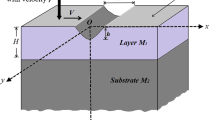Abstract
The problem of normal interaction between a compact steel isotropic cylindrical projectile and an orthotropic plate at the edge of piercing in the range of impact velocity from 50 m/s to 400 m/s. The obstacle is made of an organoplastic material with some initial orientation of its mechanical properties or the same material whose properties are obtained by a 90° rotation of the initial material about the axis OY. The destruction of obstacles is studied and the efficiency of their protective properties is comparatively analyzed depending on the orientation of the elastic and strength properties of the anisotropic material. The problem is solved numerically by the finite element method in the three-dimensional statement. The behavior of the projectile material is described by an elastoplastic model, while the response of the obstacle anisotropic material is described in the framework of the elastic-brittle model with different tensile and compressive strengths.
Similar content being viewed by others
References
A. V. Radchenko and S. V. Kobenko, “Effect of Oriented Elastic and Strength Characteristics on the Impact Fracture of Anisotropic Materials,” Dokl. Ross. Akad. Nauk 373(4), 479–482 (2000) [Dokl. Phys. (Engl. Transl.) 45 (8), 397–400 (2000)].
V. A. Gorel’skii, A. V. Radchenko, and I. E. Khorev, “Kinetic Mechanisms of the Process of Punching of Two-Layer Plates,” Izv. Akad. Nauk SSSR.Mekh. Tverd. Tela, No. 6, 185–189 (1988) [Mech. Solids (Engl. Transl.)].
M. L. Wilkins, “Calculation of Elastic-Plastic Flows,” in Numerical Methods in Hydrodynamics, (Mir, Moscow, 1967), pp. 212–263 [in Russian].
A.V. Radchenko, V. E. Fortov, and I. E. Khorev, “Physical Features of High-Velocity Interaction of Elongated Technogenic Fragments with Constructions,” Dokl. Ross. Akad. Nauk 389(1), 49–54 (2003) [Dokl. Phys. (Engl. Transl.) 48 (3), 126–130 (2003)].
E. M. Wu, “Phenomenological Failure Criteria for Anisotropic Media,” in Composite Materials, Vol. 2: Mechanics of Composite Materials (Mir, Moscow, 1978), pp. 401–492 [in Russian].
E. K. Ashkenazi and E. V. Ganov, Anisotropy of Structural Materials. Reference Book (Mashinostroenie, Leningrad, 1980) [in Russian].
A. V. Radchenko, S. V. Kobenko, I. N. Marcenuk, et al., “Research of Features of Behavior of Isotropic and AnisotropicMaterials under Impact,” Int. J. Impact. Engng 23, 745–756 (1999).
M. N. Krivosheina, A. V. Radchenko, and S. V. Kobenko, “Fracture of Orthotropic and Isotropic Spherical Bodies under the Action of a Pulse of Uniform Compression,” Mekh. Komp..Mater. Konstr. 7(1), 95–102 (1992) [J. Comp.Mech. Design (Engl. Transl.)].
E. A. Kozlov, “Shock Adiabat Features, Phase Transition Macrokinetics and Spall Fracture of Iron in Different Phase States,” High Pressure Res. 10, 541–582 (1992).
E. A. Kozlov, “Experimental Verification of E. I. Zababakhin Hypothesis Concerning Limitation of Energy Cumulation in the Spherically Converging Shock-Wave Front inMedium with Phase Transitions,” in Shock Compression of Condensed Matter (1991), pp. 169–176.
N. N. Belov, A. A. Konyaev, V. G. Simonenko, et al., “Effect of Polymorphous Phase Transformations on Explosive Compression of Steel Spheres,” Fiz. Goreniya Vzryva 33(5), 128–136 (1997) [Comb. Expl. Shock Waves (Engl. Transl.) 33 (5), 619–625 (1997)].
Author information
Authors and Affiliations
Corresponding author
Additional information
Original Russian Text © A.V. Radchenko, P.A. Radchenko, 2012, published in Izvestiya Akademii Nauk. Mekhanika Tverdogo Tela, 2012, No. 1, pp. 122–131.
About this article
Cite this article
Radchenko, A.V., Radchenko, P.A. Behavior of brittle anisotropic materials with different orientation of mechanical properties at the edge of piercing. Mech. Solids 47, 95–102 (2012). https://doi.org/10.3103/S0025654412010098
Received:
Published:
Issue Date:
DOI: https://doi.org/10.3103/S0025654412010098



